|
BY NEIGHBOURHOODS:
HARLEM & MORNINGSIDE HEIGHTS
MAP OF HARLEM AND MORNINGSIDE HEIGHTS
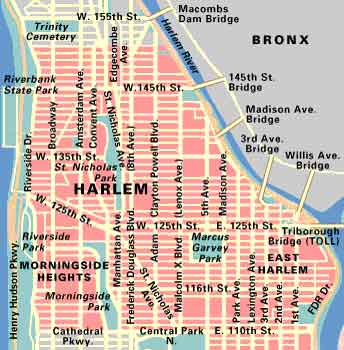
THE APOLLO THEATER
Neighbourhood: Harlem, Manhattan
Address: 253 West 125th Street, near Frederick Douglass Blvd.
Phone: (212) 749-5838
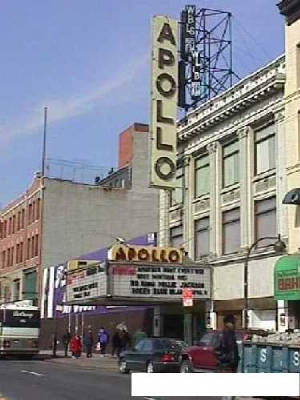
A major landmark in Harlem for over 70 years, the famous Apollo Theater was originally known as Hurtig & Seamon's
New (Burlesque) Theater.
In the early days, entertainment consisted of vaudeville and burlesque acts played to white audiences. In 1934, white entrepreneur,
Frank Schiffman, took over the Apollo. Schiffman began presenting leading black entertainers to mixed audiences and the Apollo
became the best known showcase in Harlem.
The Apollo featured many legendary black entertainers such as Bessie Smith, Billie Holiday, Duke Ellington, and Dinah Washington.
Amateur night at the Apollo was famous, and many legends such as Sarah Vaughan, Pearl Bailey, James Brown, and Gladys Knight
got their start from an amateur night appearance.
During World War II, the Apollo was a focal point for a new generation of musicians such as Charlie "Bird" Parker, Dizzy
Gillespie, Thelonius Monk, and Aretha Franklin. Today, the Apollo features the oldest amateur performance hour on radio and
television. Refurbished in the 1980s, the Apollo still features top black entertainers performing blues, jazz and gospel music.
The Apollo stands as an icon to Harlem's entertainment tradition.
CATHEDRAL OF ST.JOHN THE DIVINE
Neighbourhood: Morningside Heights, Manhattan
Address: Amsterdam Avenue at West 112th Street
Phone: (212) 316 - 7540
Hours: Daily 9:00am - 5:00pm
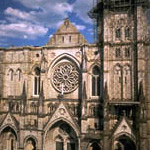
Bishop Henry Codman Potter laid the cornerstone for the Cathedral in 1892 and thus began construction for what was hoped
to be largest cathedral in the world.
It was not long before foundation problems halted construction. J.P. Morgan, the principle financier and trustee of the
cathedral, offered $500,000 to move the project forward.
The renowned mason Rafael Guastavino was employed to build the huge 162-foot high dome. By 1911, the Chapel of the Tongues
was completed. Each of the seven chapels of the cathedral was dedicated to one of the various immigrant groups that were coming
to New York Harbor during that time.
Construction continued through the depression. In 1941, the full 601-foot long by 146-foot wide magnificent cathedral was
opened to the public. Unfortunately, only a few days later, the Japanese attacked Pearl Harbor and construction on the Church
virtually stopped. Pearl Harbor Arch shows the incomplete masonry of a worker who, went to war and never came home to his
work.
Construction on the cathedral was at a standstill for 32 years. In 1972, the Rev. James Parks Morton, revived enthusiasm
for completion of the church. His idea was to employ members of the surrounding community to assist in the building efforts.
Master stone carvers were brought from England to train the workers and a stonemasons yard was added in 1978.
The church was designed using medieval construction methods, such as stone supporting buttresses. Many interesting pieces
of sculpture, artwork, and stained glass are on display throughout the Cathedral. The Rose window, for example, represents
the many facets of the Christian Church. A portal, designed by local stonemason Joe Kinkannon, depicts an apocalyptic vision
of New York City at the west front entrance. Bronze lamps from the demolished Pennsylvania Railroad Station were installed
on the front steps in 1967. Now two-thirds complete, there are no new plans for construction in the near future. The Towers,
the Transepts, the Great Crossing, and the Choir roof remain unfinished. The cost to finish the project will be approximately
400 million dollars and it will take at least another 50 years to complete.
THE STUDIO MUSEUM
Neighbourhood: Harlem, Manhattan
Address: 144 West 125th Street
Phone: (212) 864 - 4500
Hours: Wed - Fri 10:00am - 5:00pm, Sat, Sun 1:00pm - 6:00pm
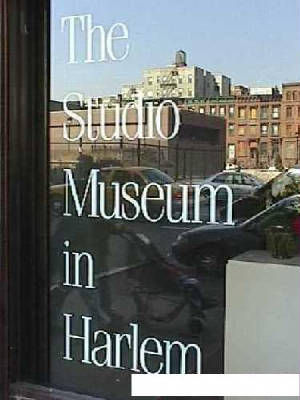
The Studio Museum was originally opened in a loft on Upper Fifth Avenue in 1967.
It began with a vision and the goal of becoming the foremost exhibition of African-American Art and artifacts in the world
with an emphasis on nineteenth and twentieth century artists.
The present building opened in 1982 and was donated by the New York Bank for Savings. The museum has a permanent collection
of over 1,500 pieces divided into three categories: nineteenth and twentieth century African-American art; twentieth century
Caribbean and African Art; and traditional African Art and artifacts. Each year, the museum exhibits works by three promising
black artists from within the museum? artists-in-residence program.
The photo archive contains the most comprehensive collection of photographs of Harlem in existence. Regular, changing themes
highlight the works of various black artists throughout the year. Lectures, seminars, children? programs, and film festivals
are also offered. The small, but well stocked museum store offers a variety of books on, and examples of, African Art.
MUSEUM OF THE CITY OF NEW YORK
Neighbourhood: Upper East Side, Manhattan
Address: 5th Avenue at 103rd Street
Phone: (212) 534-1672
Hours: Wednesday - Saturday, 10:00am - 5:00pm; Tuesday, 10:00am - 2:00pm for preregistered groups
only; Sunday, noon - 5:00pm; closed: Mondays and all legal holidays
Located on Manhattan's "Museum Mile", the Museum of the City of New York (MCNY) is a non-profit, private educational
organization established in 1923, to collect, preserve, and present original cultural materials related to the history of
New York City. This is a great place to explore what has made New York one of history's greatest cities.
Lifetimes of information and experiences are presented in the many changing exhibitions. Visitors have a chance to see
and experience the way so many cultures and heritages were blended into the city that has been nicknamed "The Big Apple."
By exploring these exhibits, visitors travel through time from the period when New York City was a colonial Dutch outpost
to the incredibly vibrant city visitors see today. The museum documents the city's history with an impressive display of costumes,
paintings, furnishings, toys, and a large array of memorabilia. This is truly New York's premier history museum. The museum
offers educational programs and changes the topics of the exhibits regularly. In addition, the museum provides function rooms
with a capacity of 450 guests for banquets or 900 for receptions.
UPPER WEST SIDE
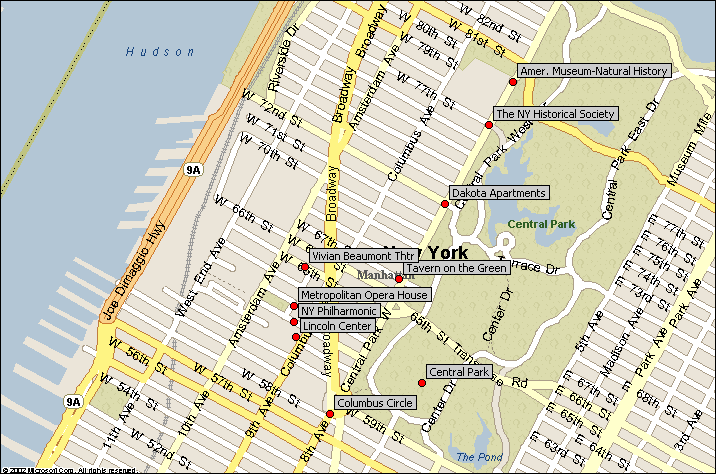
THE AMERICAN MUSEUM OF NATURAL HISTORY
Neighbourhood: Upper West Side, Manhattan
Address: Central Park West (8th Avenue) at 79th Street
Phone: (212) 769-5100
Hours: Sunday to Thursday, 10:00am - 5:45pm; Friday to Saturday 10:00am - 8:45pm;
closed: Christmas and Thanksgiving day

The American Museum of Natural History is home to the largest collection of insects, amphibians, ocean life, reptiles,
anthropological artifacts, fossil mammals and dinosaurs in the world. It houses over 36 million artifacts that will guarantee
a memorable visit, regardless of your interests.
Opened in 1869, the museum now has over 200 working scientists and several million visitors each year. One of the most
popular displays is a replica of a ninety-four foot female Blue Whale which was captured off the southern coast of America
in 1925. Another favorite is a giant four-and-a half-billion-year-old meteorite found in Greenland.
The Hall of Minerals and Gems contains jewels valued at nearly $50 million; and the Theodore Roosevelt Rotunda contains
a Barosaurus fossil which is the largest freestanding dinosaur exhibit in the world. The museum also presents special exhibits
like the recent ?pidemic! World of Infectious Diseases?which explains how the mixture of ecology, evolution, and culture can
produce conditions in which deadly microbes thrive. The museum also has an IMAX Theater and the Hayden Planetarium. Free
museum tours are available, and visitors should come with comfortable shoes and some extra time, because it's unlikely you'll
want to leave.
CENTRAL PARK
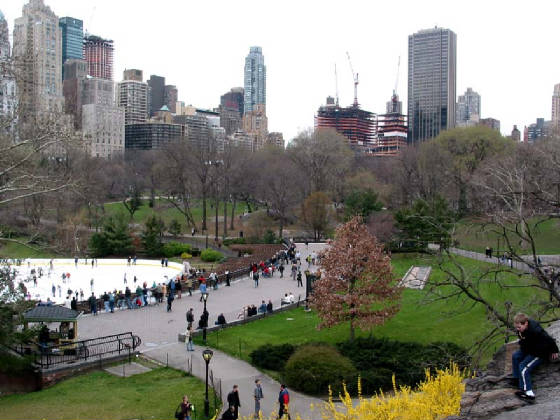
BELVEDERE CASTLE
Neighbourhood: Central Park, Manhattan
Address: 79th Street Transverse
Phone: (212) 772-0210
Hours: Tuesday-Sunday: 10:00am - 5:00pm, Daylight Savings Time; 10:00am - 4:00pm, Eastern Standard Time.
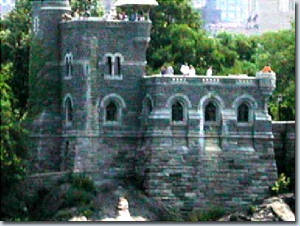
Built in 1869 and once used by the New York Meteorological Observatory, the Castle is still used as a U.S. Weather Service
Station. Belvedere Castle sits atop Vista Rock and is the highest point in Central Park. It offers some of the best views
of the City and park anywhere.
The new Henry Luce Nature Observatory is housed inside the castle, and young visitors can see exhibits that include reproductions
of trees as well as many of the birds and much of the surprisingly diverse wildlife found in the park.
The nearby Delecorte Theater offers free productions of Shakespeare every summer. The theater was a gift from philanthropist
and founder of Dell Paperback Publications, George T. Delacorte. Many of Central Park? attractions can be attributed to Delacorte
who, in addition to his generosity, is often described as a genuinely nice person, well-liked by nearly all who met him.
STRAWBERRY FIELDS
Neighbourhood: Central Park, Manhattan
Address: West Drive and 72nd Street Transverse
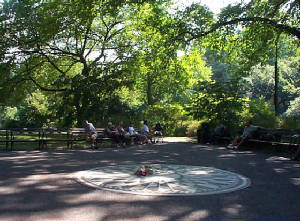
Strawberry Fields is one of the most visited spots in Central Park. Yoko Ono had this area restored in memory of her slain
husband, ex-Beatle, John Lennon. Lennon would often play with his son, Sean, in this area.
The nearby Dakota apartments, where the Lennons lived, overlook Strawberry Fields, which covers an area of Central Park
shaped like a tear drop. This international peace garden was largely made using gifts received from all over the world.
The city of Naples, Italy, donated the mosaic with the word, Imagine (a famous song written by Lennon), inscribed in the pathway.
One hundred sixty species of plants are grown within its garden, one from every country in the world. Jetbead, roses, and
-- as you might imagine -- strawberries are grown here.
UPPER EAST SIDE
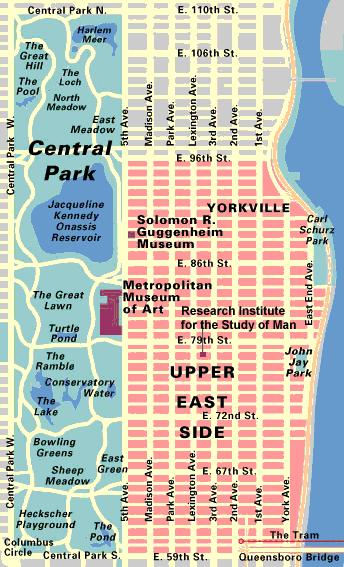
COOPER-HEWITT NATIONAL DESIGN MUSEUM
Neighbourhood: Upper East Side, Manhattan
Address: 2 East 91st Street at 5th Avenue
Phone: (212) 849-8300
Hours: Tuesday, 10:00am - 9:00pm; Wednesday - Saturday, 10:00am - 5:00 pm;
Sunday, noon - 5pm; closed: public holidays
Located in the former home of industrialist Andrew Carnegie, the Cooper-Hewitt National Design Museum shelters one of
the largest design collections in the world. The collection was gathered by the Hewitt sisters Amy, Eleanor, and Sarah.
First opened in 1897 at Cooper Union (30 Cooper Square), the collection was acquired by The Smithsonian in 1967. The Carnegie
Corporation offered the mansion to the Smithsonian in 1968, and in 1976 the collection opened in the Carnegie home. Built
in 1902, the Carnegie home is a 64-room mansion, designed by Babb, Cook & Willard. Although Carnegie asked for "the plainest
and most roomy house in New York," he got a house that included some of the most novel features of the day. The house was
equipped with central heating, air-conditioning, and a passenger elevator. The original gardens are still open to the public.
The design collection is intended to stimulate thought on issues of creation and consequence of design. Scholarly works
and pieces on loan from public and private sources are part of an ever-changing exhibition. The museum presents collections
from schools of study that include graphic design, industrial design, and architecture. Items on display include rare books,
textiles, wall coverings, furniture, ceramics, glass, metalwork and jewelry.
METROPOLITAN MUSEUM OF ART
Neighbourhood: Upper East Side
Address: 1000 Fifth Avenue at 82nd Street
Phone: (212) 535-7710
Hours: Friday,
Saturday: 9:30am - 8:45pm; Sunday, Tuesday to Thursday: 9:30am - 5:15pm; Closed: Mondays and Thanksgiving Day, December 25,
January 1
The Metropolitan Museum of Art contains one of the largest collections of art in the world. The Met is home to over two
million works of art, with several hundred thousand works on display at any one given time.
The Costume Institute, located on the ground floor of the museum, contains over 45,000 pieces of fashion and regional costuming
dating from the 17th century to the present. The Department of Egyptian art, located on the first floor of the museum, boasts
one of the largest collections of Egyptian art outside Egypt. Also on display is a fully-equipped violin-maker's workshop
as well as the oldest extant piano which was made in 1720. The Metropolitan Museum of Art is truly a "must-see".
THEATER DISTRICT
RADIO CITY MUSIC HALL
Neighbourhood: Theater District, Manhattan
Address: 50th Street at Avenue of the Americas (6th Avenue)
Phone: (212) 247-4777

One of the most popular and spectacular venues in New York City, Radio City Music Hall has been delighting audience members
since it first opened in 1932. Conceived by S.L. "Roxy" Rothafel, it was the largest indoor theater in the world at the time.
The theater was designed in the Art Deco style which utilizes glass, aluminum, chrome, and geometric ornamentation. The
famous marquee, a full city block in length, consists of more than six miles of red and blue neon tubes. The Grand Foyer ceiling
is adorned with 24-carat gold leaf.
Above the Grand Staircase, in the Grand Foyer, is a huge mural by Erzra Winter. The sixty foot by thirty foot mural depicts
mankind in his pursuit of eternal youth. The Wurlitzer Organ, a 1932 original, has two independent consoles on each side of
the stage. An organist is able to reproduce the sound of an entire orchestra using the features of this organ. The auditorium
is truly breathtaking. Inspired by a cruise on an ocean-liner, Rothafels wanted the auditorium to resemble the sun setting
on an ocean of red velvet seats.
Synonymous with Radio City Music Hall is the Rockette? Chorus Line. They were founded in 1925 when Russell Markert began
selecting dancing girls for the Missouri Rockets precision dance team. The troupe toured the country and eventually found
a permanent home in New York. ?oxy?Rothafel saw them and decided he wanted them for his new Roxy Theater. He renamed them
?he Roxyettes.?Eventually, the chorus line was expanded and the name was changed to ?he Rockette?.?Today, there are over 175
women in The Rockette? dance troupe. Their Easter performances and Christmas spectaculars are popular events for visitors
and New Yorkers, alike. In 1979, Radio City moved beyond its traditional movie/stage format, and it now presents spectacular
live stage performances, concerts, television events, and Hollywood movie premiers
ROCKEFELLER CENTER
Neighbourhood: Theater District
Address: 47th to 51st streets between Fifth and Sixth avenues

In 1928, John D. Rockefeller envisioned Rockefeller Center as the site of three huge office buildings and an ideally-located
opera house. The stock market crash of 1929 forced him to re-evaluate his plans. The opera house backed out of its deal and
the whole project was sent into disarray and confusion.
Not to be thwarted, Rockefeller and his lead architect, Raymond Hood, set to work on what was to become the first integrated
office complex in the world, combining shops, gardens, restaurants and entertainment.
The first of 14 buildings was completed during the depression era between 1931 and 1940, and provided jobs for over 225,000
people. Thirty Rockefeller Plaza, with its gilded statue of Prometheus at the entrance, was another of the early buildings
constructed and is the largest. The famous Radio City Music Hall was added in 1932 and features the famous Rockettes Chorus
line, a highlight during the Christmas and Easter season. The music hall, which features year-round entertainment from top-notch
performers, seats 5,874 people, and is an Art Deco masterpiece.
Another of the magnificent treasures found at Rockefeller Center is the statue of Atlas. Lee Lawrie designed this 4,000
lb (1,800 kg) bronze statue at the entrance to the International Building on Fifth Avenue at West 50th Street. Atlas is just
one of twelve Lawrie works that one can view at Rockefeller Center.
Known as much for its outdoor spaces as it is
for its indoor areas, Rockefeller Center features an outdoor cafe, the sloping Channel Garden, and a skating rink. If you
plan to visit New York City during the Christmas season, be sure to see the world's largest decorated Christmas tree, located
right next to the skating rink. Beneath Rockefeller Center is a vast shopping extravaganza. There are upscale shops
of all types here, and visitors can purchase anything from Japanese books to Italian leather goods. For special gifts, visit
the Metropolitan Museum of Art Store or Agatha, which offers French costume jewelry.
MIDTOWN
CHRYSLER BUILDING
Neighbourhood: Midtown, Manhattan
Address: Lexington Avenue at 42nd Street
Height: 1048 feet (77
floors)
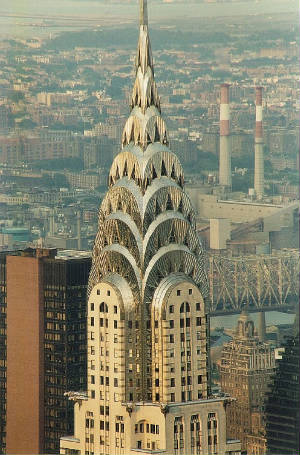
|

